A Fast CFD-Based Methodology for Determining the Cyclic Variability and Its Effects on Performance and Emissions of Spark-Ignition Engines
Abstract
1. Introduction
2. Spark-Ignition Engine and Experimental Data
3. Numerical Model and Methodology
3.1. Highlights of the CFD Code and Its Main Sub-Models
3.2. Brief Description of the Cyclic Variability Sub-Model
3.3. The Fast Methodology for Estimating the Key Parameters of Cyclic Variability in SI Engines
4. Results and Discussion
4.1. Cyclic Variability of Engine Performance
4.2. Cyclic Variability of Emissions
4.2.1. NO Emissions
4.2.2. CO Emissions
5. Conclusions
Author Contributions
Funding
Acknowledgments
Conflicts of Interest
References
- Truffin, K.; Angelberger, C.; Richard, S.; Pera, C. Using large-eddy simulation and multivariate analysis to understand the sources of combustion cyclic variability in a spark-ignition engine. Combust. Flame 2015, 162, 4371–4390. [Google Scholar] [CrossRef]
- Labeckas, G.; Slavinskas, S.; Kanapkienė, I. The individual effects of cetane number, oxygen content or fuel properties on the ignition delay, combustion characteristics, and cyclic variation of a turbocharged CRDI diesel engine—Part 1. Energy Convers. Manag. 2017, 148, 1003–1027. [Google Scholar] [CrossRef]
- Rakopoulos, C.D.; Rakopoulos, D.C.; Kosmadakis, G.M.; Papagiannakis, R.G. Experimental comparative assessment of butanol or ethanol diesel-fuel extenders impact on combustion features, cyclic irregularity, and regulated emissions balance in heavy-duty diesel engine. Energy 2019, 174, 1145–1157. [Google Scholar] [CrossRef]
- Rakopoulos, D.C.; Rakopoulos, C.D.; Kyritsis, D.C. Butanol or DEE blends with either straight vegetable oil or biodiesel excluding fossil fuel: Comparative effects on diesel engine combustion attributes, cyclic variability and regulated emissions trade-off. Energy 2016, 115, 314–325. [Google Scholar] [CrossRef]
- Rakopoulos, D.C.; Rakopoulos, C.D.; Giakoumis, E.G.; Komninos, N.P.; Kosmadakis, G.M.; Papagiannakis, R.G. Comparative evaluation of ethanol, n-butanol, and diethyl ether effects as biofuel supplements on combustion characteristics, cyclic variations, and emissions balance in light-duty diesel engine. J. Energy Eng. 2016, 143, 4016044. [Google Scholar] [CrossRef]
- Ozdor, N.; Dulger, M.; Sher, E. Cyclic Variability in Spark Ignition Engines a Literature Survey; SAE Technical Paper 940987; SAE International: Warrendale, PA, USA; Troy, MI, USA, 1994. [Google Scholar]
- Hill, P.G. Cyclic variations and turbulence structure in spark-ignition engines. Combust. Flame 1988, 72, 73–89. [Google Scholar] [CrossRef]
- Karvountzis-Kontakiotis, A.; Ntziachristos, L.; Samaras, Z.; Dimaratos, A.; Peckham, M. Experimental investigation of cyclic variability on combustion and emissions of a high-speed SI engine. In Proceedings of the SAE 2015-01-0742; SAE Technical Paper; SAE International: Warrendale, PA, USA, 2015. [Google Scholar]
- Aleiferis, P.G.; Hardalupas, Y.; Taylor, A.; Ishii, K.; Urata, Y. Flame chemiluminescence studies of cyclic combustion variations and air-to-fuel ratio of the reacting mixture in a lean-burn stratified-charge spark-ignition engine. Combust. Flame 2004, 136, 72–90. [Google Scholar] [CrossRef]
- Brown, A.G.; Stone, C.R.; Beckwith, P. Cycle-By-Cycle Variations in Spark Ignition Engine Combustion-Part I: Flame Speed and Combustion Measurements and a Simplified Turbulent Combustion Model; SAE Technical Paper 960612; SAE International: Warrendale, PA, USA; Troy, MI, USA, 1996. [Google Scholar]
- Fontana, G.; Galloni, E. Experimental analysis of a spark-ignition engine using exhaust gas recycle at WOT operation. Appl. Energy 2010, 87, 2187–2193. [Google Scholar] [CrossRef]
- Huang, B.; Hu, E.; Huang, Z.; Zheng, J.; Liu, B.; Jiang, D. Cycle-by-cycle variations in a spark ignition engine fueled with natural gas–hydrogen blends combined with EGR. Int. J. Hydrogen Energy 2009, 34, 8405–8414. [Google Scholar] [CrossRef]
- Beretta, G.P.; Rashidi, M.; Keck, J.C. Turbulent flame propagation and combustion in spark ignition engines. Combust. Flame 1983, 52, 217–245. [Google Scholar] [CrossRef]
- Karvountzis-Kontakiotis, A.; Dimaratos, A.; Ntziachristos, L.; Samaras, Z. Exploring the stochastic and deterministic aspects of cyclic emission variability on a high speed spark-ignition engine. Energy 2017, 118, 68–76. [Google Scholar] [CrossRef]
- Stone, C.R.; Brown, A.G.; Beckwith, P. Cycle-By-Cycle Variations in Spark Ignition Engine Combustion—Part II: Modelling of Flame Kernel Displacements as a Cause of Cycle-By-Cycle Variations; SAE Technical Paper 960613; SAE International: Warrendale, PA, USA; Troy, MI, USA, 1996. [Google Scholar]
- Tinaut, F.V.; Giménez, B.; Horrillo, A.J.; Cabaco, G. Use of Multizone Combustion Models to Analyze and Predict the Effect of Cyclic Variations on SI Engines; SAE Technical Paper 2000-01-0961; SAE International: Warrendale, PA, USA; Troy, MI, USA, 2000. [Google Scholar]
- Rakopoulos, C.D.; Rakopoulos, D.C.; Mavropoulos, G.C.; Kosmadakis, G.M. Investigating the EGR rate and temperature impact on diesel engine combustion and emissions under various injection timings and loads by comprehensive two-zone modeling. Energy 2018, 157, 990–1014. [Google Scholar] [CrossRef]
- Forte, C.; Corti, E.; Bianchi, G.M.; Falfari, S.; Fantoni, S. A RANS CFD 3D Methodology for the Evaluation of the Effects of Cycle by Cycle Variation on Knock Tendency of a High Performance Spark Ignition Engine; SAE Technical Paper 2014-01-1223; SAE International: Warrendale, PA, USA; Troy, MI, USA, 2014. [Google Scholar]
- Vermorel, O.; Richard, S.; Colin, O.; Angelberger, C.; Benkenida, A.; Veynante, D. Towards the understanding of cyclic variability in a spark ignited engine using multi-cycle LES. Combust. Flame 2009, 156, 1525–1541. [Google Scholar] [CrossRef]
- Granet, V.; Vermorel, O.; Lacour, C.; Enaux, B.; Dugué, V.; Poinsot, T. Large-Eddy Simulation and experimental study of cycle-to-cycle variations of stable and unstable operating points in a spark ignition engine. Combust. Flame 2012, 159, 1562–1575. [Google Scholar] [CrossRef]
- Van Dam, N.; Rutland, C. Understanding in-cylinder flow variability using large-eddy simulations. J. Eng. Gas Turbines Power 2016, 138, 102809. [Google Scholar] [CrossRef]
- D’Adamo, A.; Breda, S.; Berni, F.; Fontanesi, S. Understanding the origin of cycle-to-cycle variation using large-eddy simulation: Similarities and differences between a homogeneous low-revving speed research engine and a production DI turbocharged engine. SAE Int. J. Engines 2019, 12, 79–100. [Google Scholar] [CrossRef]
- Scarcelli, R.; Sevik, J.; Wallner, T.; Richards, K.; Pomraning, E.; Senecal, P.K. Capturing Cyclic Variability in Exhaust Gas Recirculation Dilute Spark-Ignition Combustion Using Multicycle RANS. J. Eng. Gas Turbines Power 2016, 138, 112803. [Google Scholar] [CrossRef]
- Kosmadakis, G.M.; Rakopoulos, D.C.; Arroyo, J.; Moreno, F.; Muñoz, M.; Rakopoulos, C.D. CFD-based method with an improved ignition model for estimating cyclic variability in a spark-ignition engine fueled with methane. Energy Convers. Manag. 2018, 174, 769–778. [Google Scholar] [CrossRef]
- Kosmadakis, G.M.; Rakopoulos, D.C.; Rakopoulos, C.D. Performance and emissions of a methane-fueled spark-ignition engine under consideration of its cyclic variability by using a computational fluid dynamics code. Fuel 2019, 258, 116154. [Google Scholar] [CrossRef]
- Arroyo, J.; Moreno, F.; Muñoz, M.; Monné, C.; Bernal, N. Combustion behavior of a spark ignition engine fueled with synthetic gases derived from biogas. Fuel 2014, 117, 50–58. [Google Scholar] [CrossRef]
- Moreno, F.; Arroyo, J.; Muñoz, M.; Monne, C. Combustion analysis of a spark ignition engine fueled with gaseous blends containing hydrogen. Int. J. Hydrogen Energy 2012, 37, 13564–13573. [Google Scholar] [CrossRef]
- Rakopoulos, C.D.; Kosmadakis, G.M.; Pariotis, E.G. Evaluation of a combustion model for the simulation of hydrogen spark-ignition engines using a CFD code. Int. J. Hydrogen Energy 2010, 35, 12545–12560. [Google Scholar] [CrossRef]
- Rakopoulos, C.D.; Kosmadakis, G.M.; Pariotis, E.G. Critical evaluation of current heat transfer models used in CFD in-cylinder engine simulations and establishment of a comprehensive wall-function formulation. Appl. Energy 2010, 87, 1612–1630. [Google Scholar] [CrossRef]
- Rakopoulos, C.D.; Kosmadakis, G.M.; Dimaratos, A.M.; Pariotis, E.G. Investigating the effect of crevice flow on internal combustion engines using a new simple crevice model implemented in a CFD code. Appl. Energy 2011, 88, 111–126. [Google Scholar] [CrossRef]
- Kosmadakis, G.M.; Rakopoulos, C.D. Computational fluid dynamics study of alternative nitric-oxide emission mechanisms in a spark-ignition engine fueled with hydrogen and operating in a wide range of exhaust gas recirculation rates for load control. J. Energy Eng. 2015, 141, C4014008. [Google Scholar] [CrossRef]
- Kosmadakis, G.M.; Rakopoulos, D.C.; Rakopoulos, C.D. Investigation of nitric oxide emission mechanisms in a SI engine fueled with methane/hydrogen blends using a research CFD code. Int. J. Hydrogen Energy 2015, 40, 15088–15104. [Google Scholar] [CrossRef]
- Kosmadakis, G.M.; Rakopoulos, D.C.; Rakopoulos, C.D. Methane/hydrogen fueling a spark-ignition engine for studying NO, CO and HC emissions with a research CFD code. Fuel 2016, 185, 903–915. [Google Scholar] [CrossRef]
- Hinze, P.C. Cycle-To-Cycle Combustion Variations in a Spark-Ignition Engine Operating at Idle; Massachusetts Institute of Technology: Cambridge, MA, USA, 1997. [Google Scholar]
- Tabaczynski, R.J.; Trinker, F.H.; Shannon, B.A.S. Further refinement and validation of a turbulent flame propagation model for spark-ignition engines. Combust. Flame 1980, 39, 111–121. [Google Scholar] [CrossRef]
- Hires, S.D.; Tabaczynski, R.J.; Novak, J.M. The Prediction of Ignition Delay and Combustion Intervals for a Homogeneous Charge, Spark Ignition Engine; SAE Technical Paper 780232; SAE International: Warrendale, PA, USA; Troy, MI, USA, 1978. [Google Scholar]
- Zimont, V.L. Gas premixed combustion at high turbulence. Turbulent flame closure combustion model. Exp. Therm. Fluid Sci. 2000, 21, 179–186. [Google Scholar] [CrossRef]
- Ouimette, P.; Seers, P. Numerical comparison of premixed laminar flame velocity of methane and wood syngas. Fuel 2009, 88, 528–533. [Google Scholar] [CrossRef]
- Kyrtatos, P.; Zivolic, A.; Brückner, C.; Boulouchos, K. Cycle-to-cycle variations of NO emissions in diesel engines under long ignition delay conditions. Combust. Flame 2017, 178, 82–96. [Google Scholar] [CrossRef]
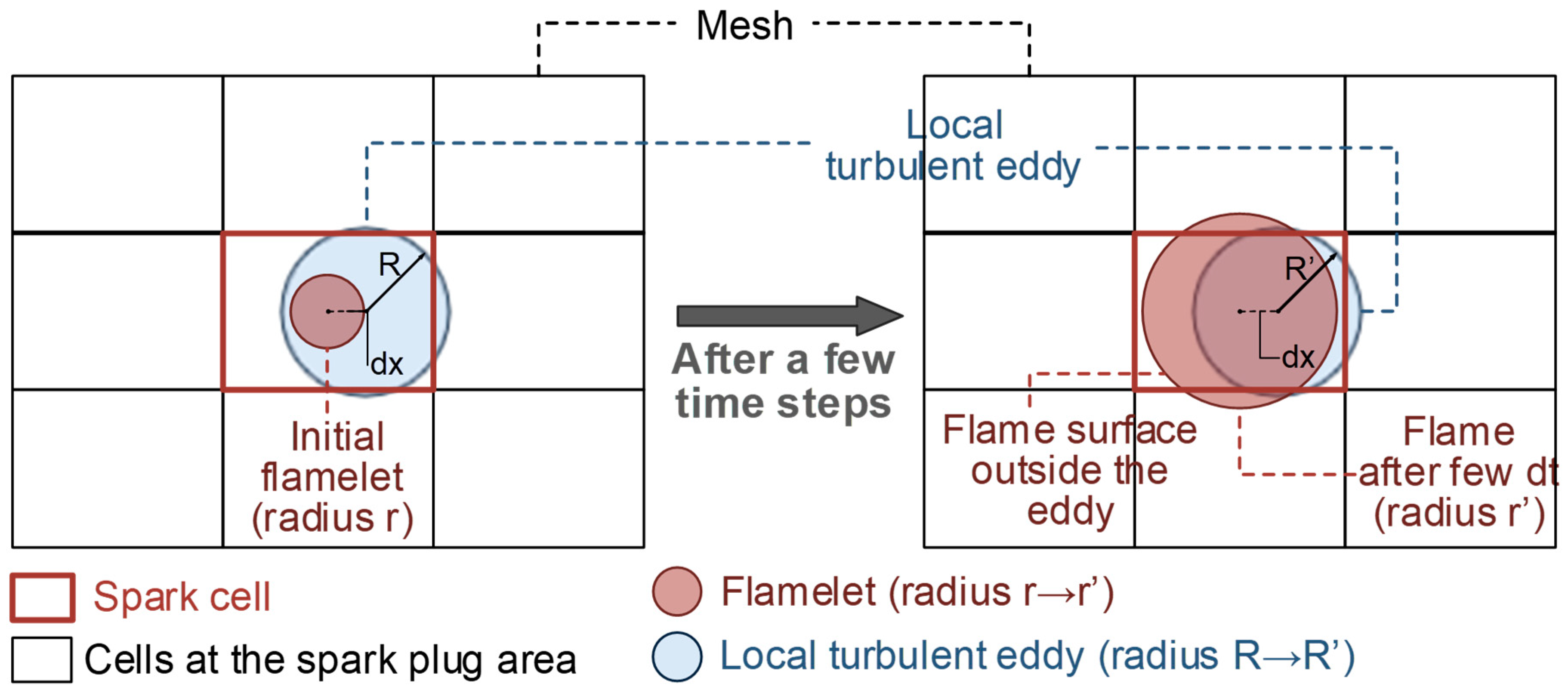
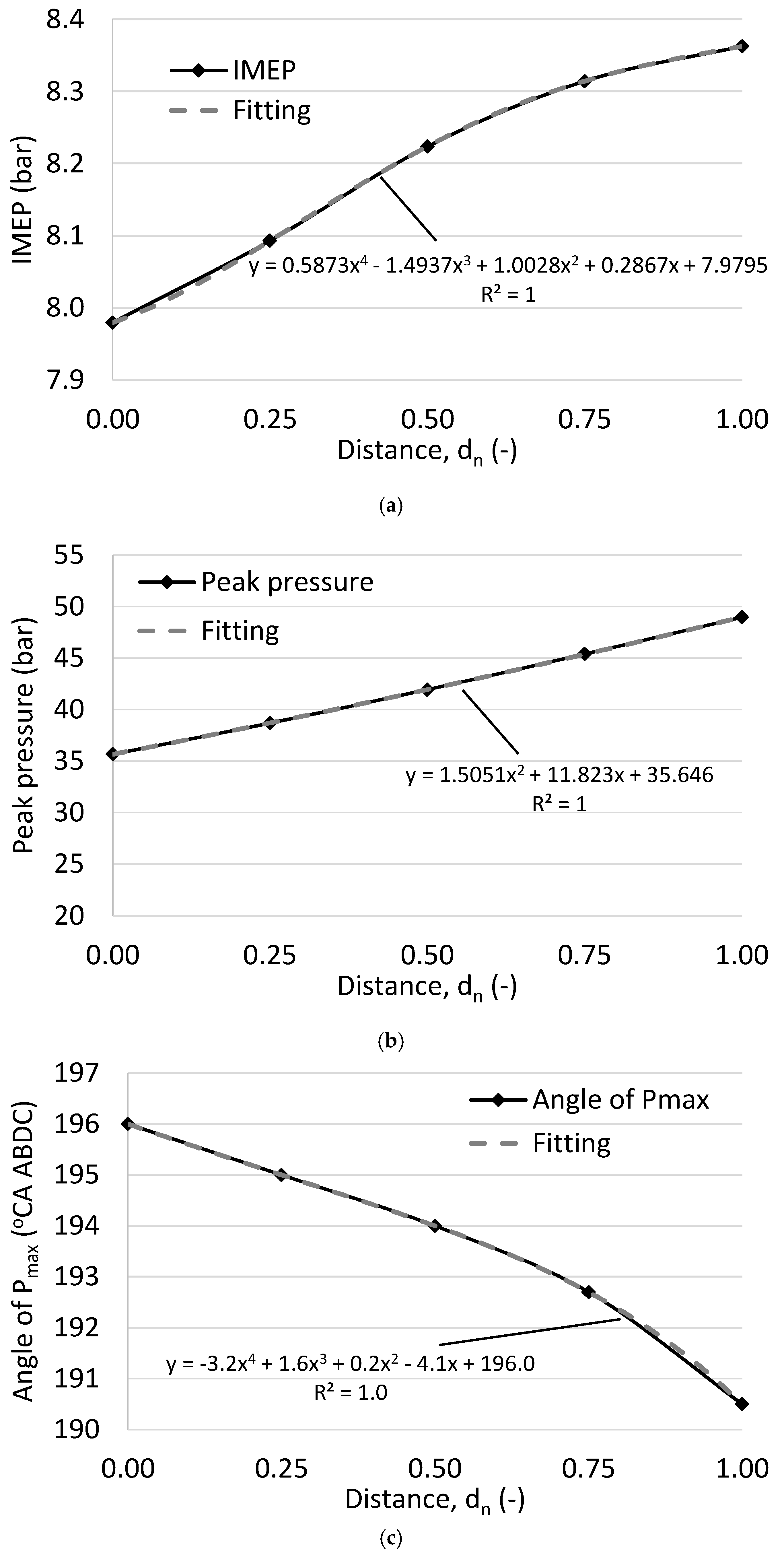
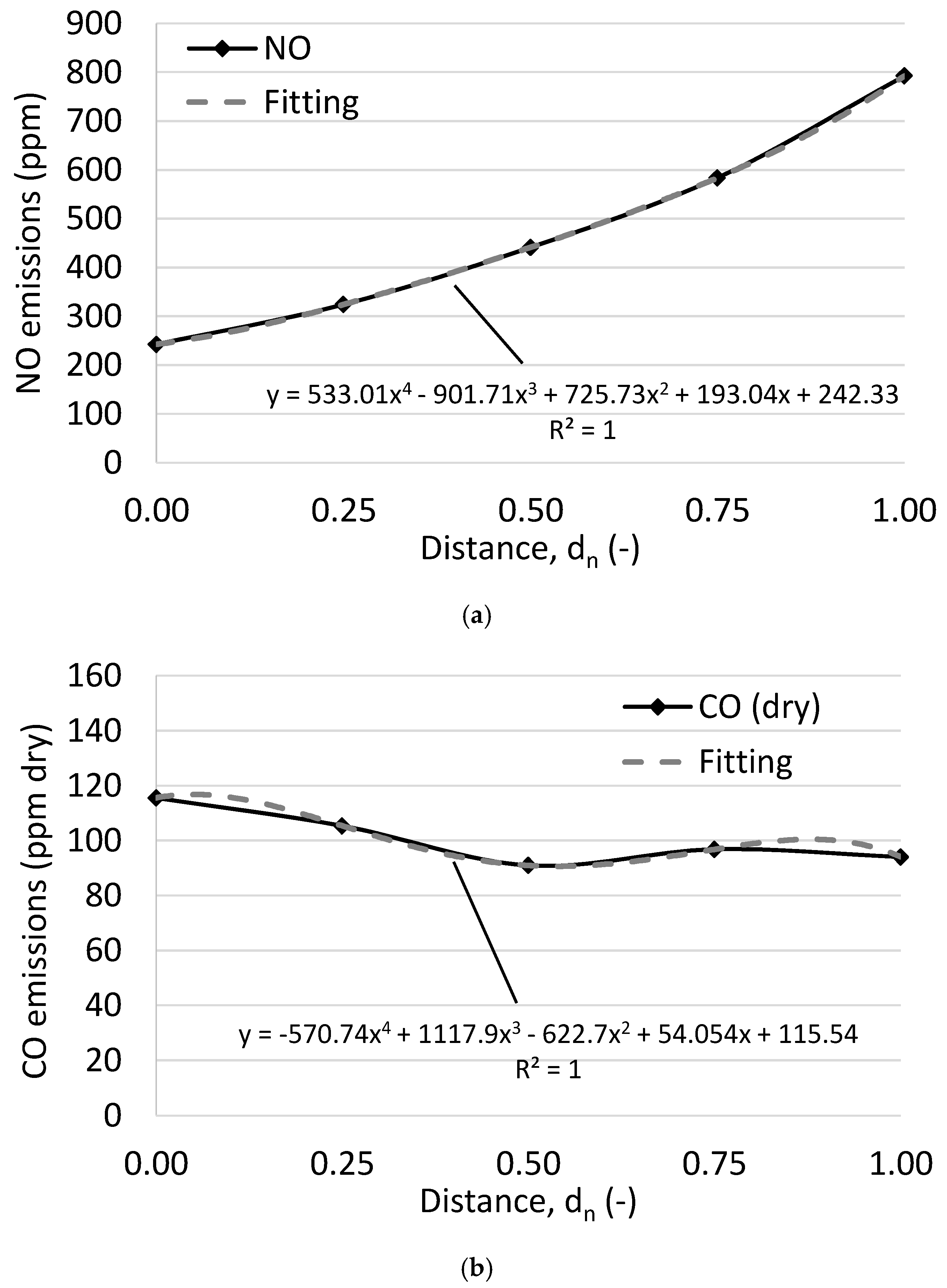
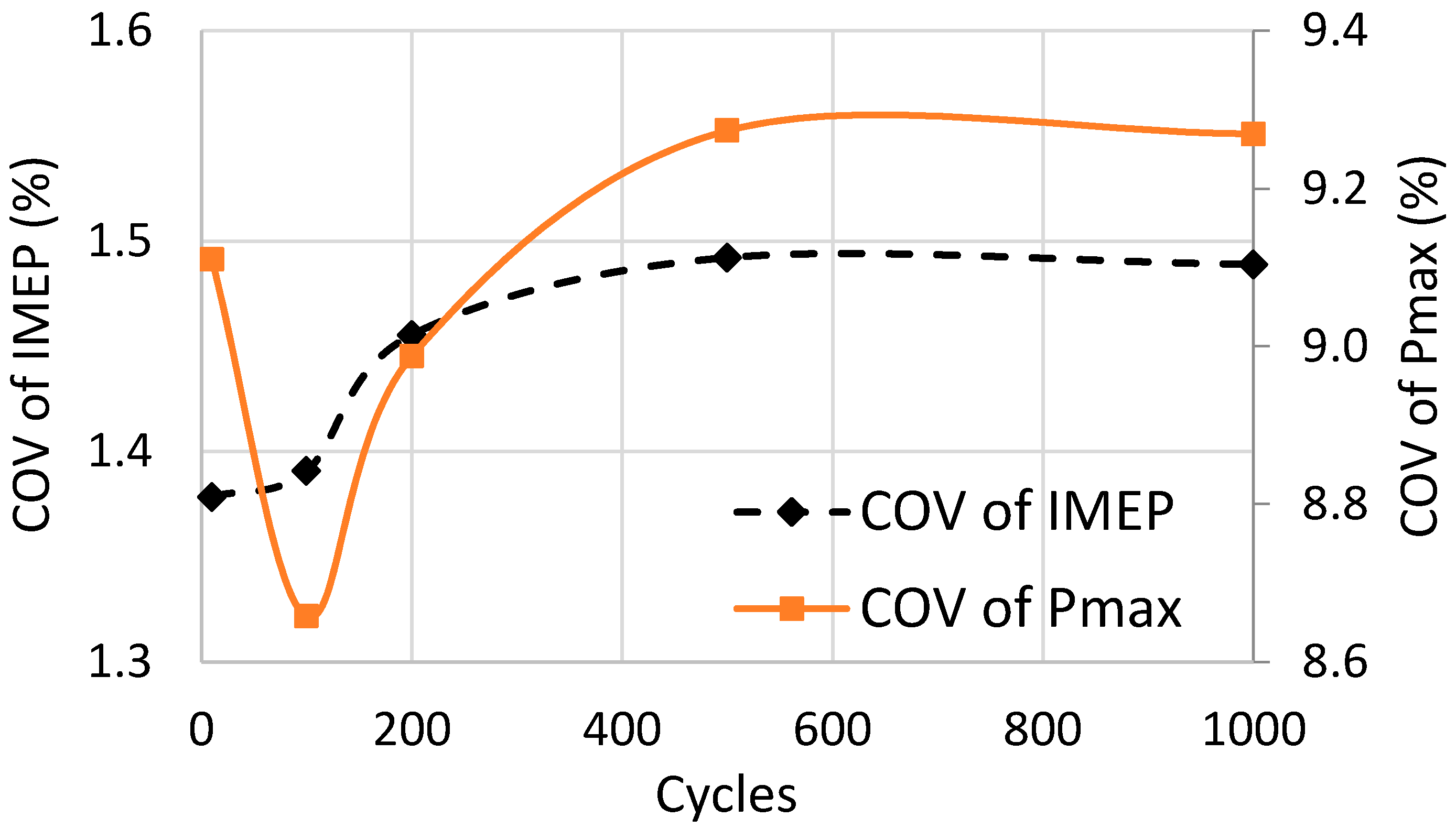
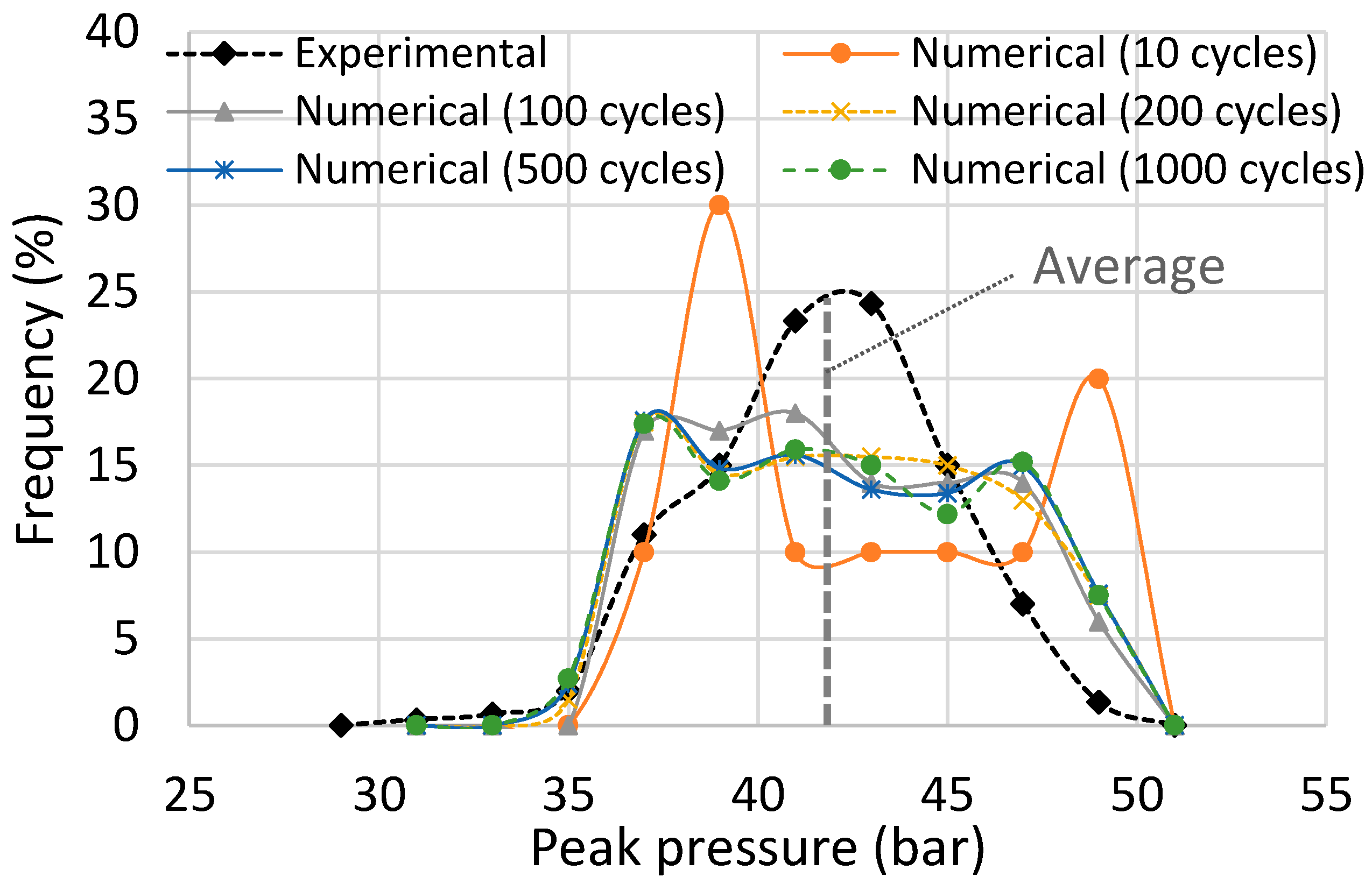
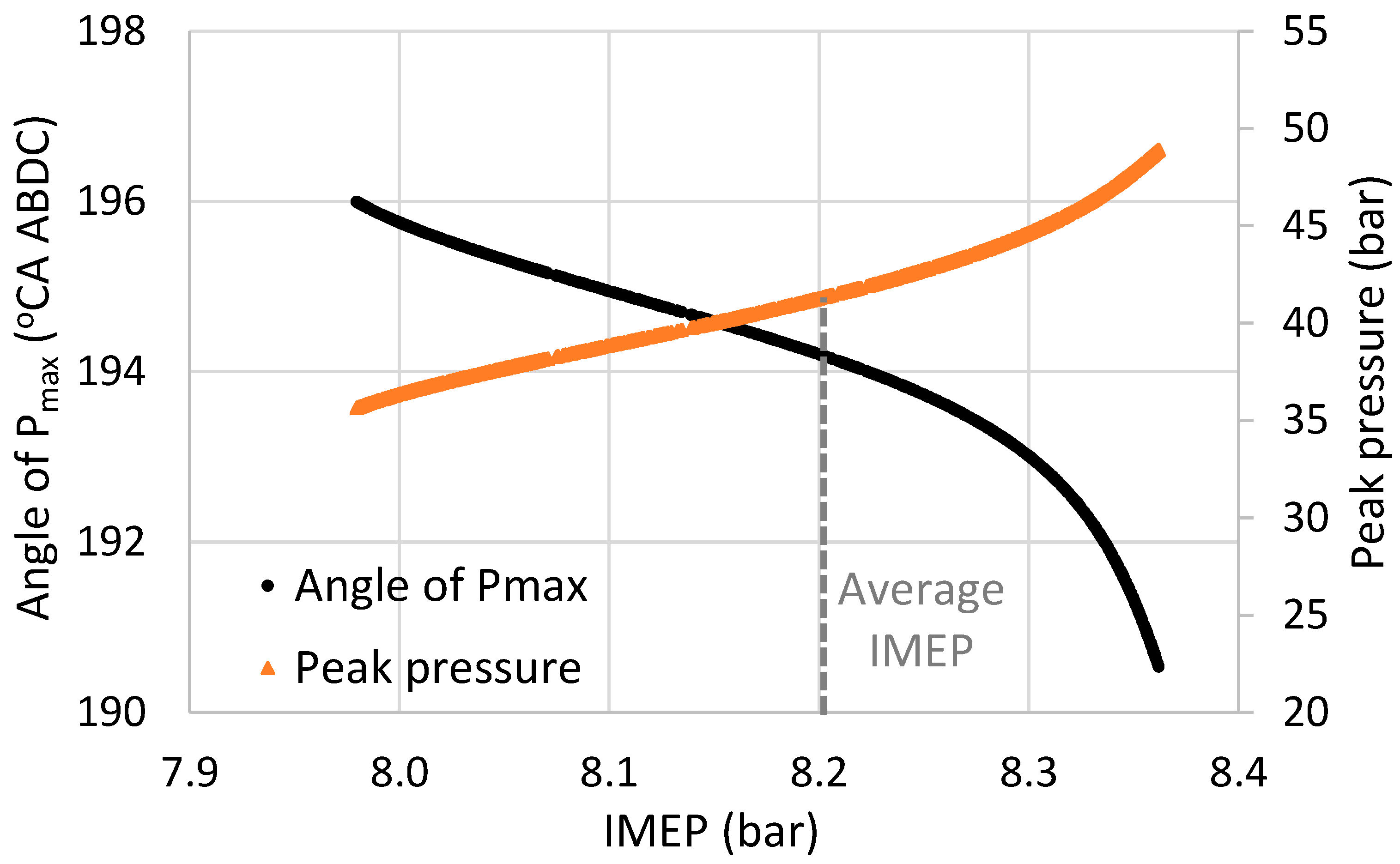
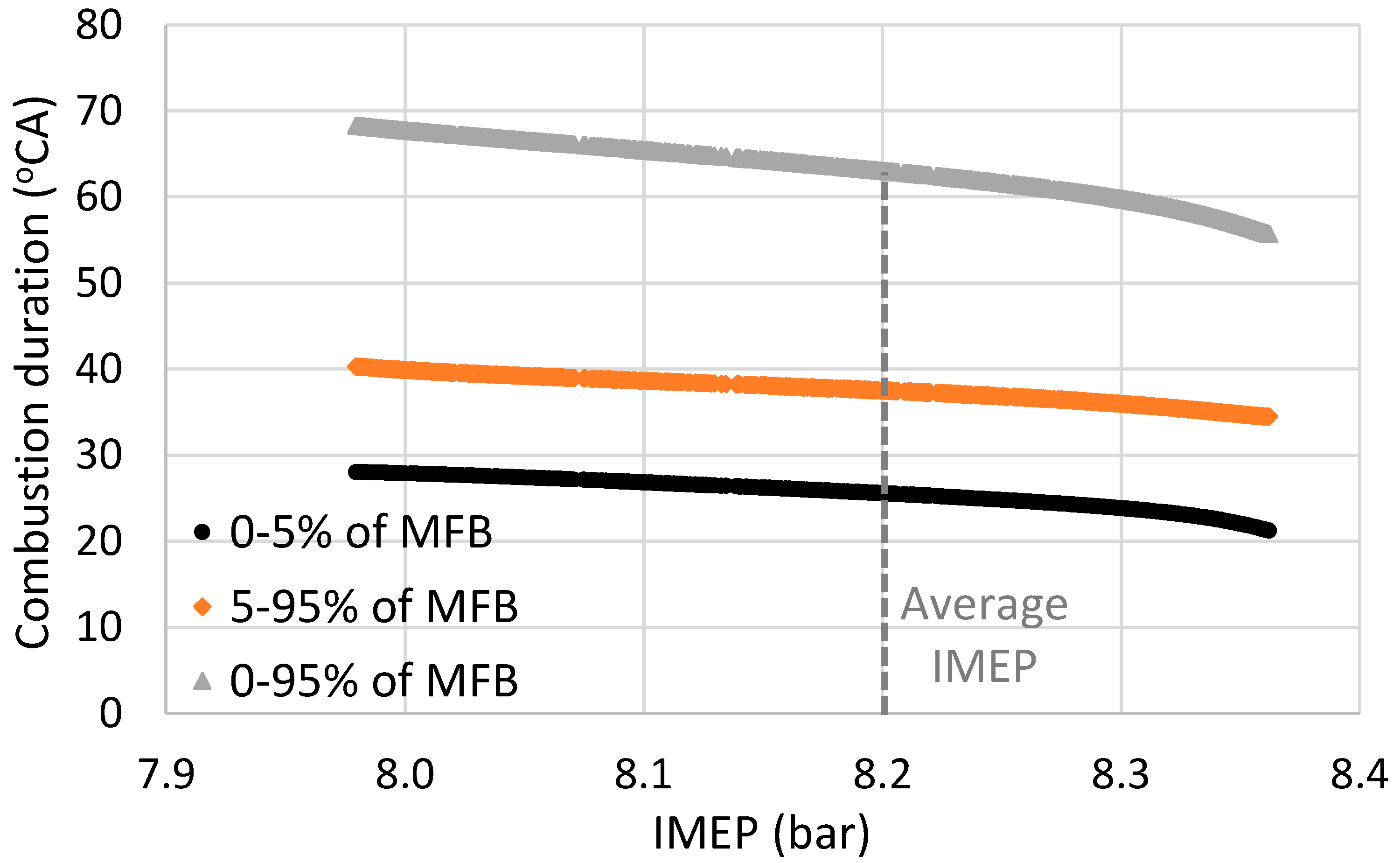
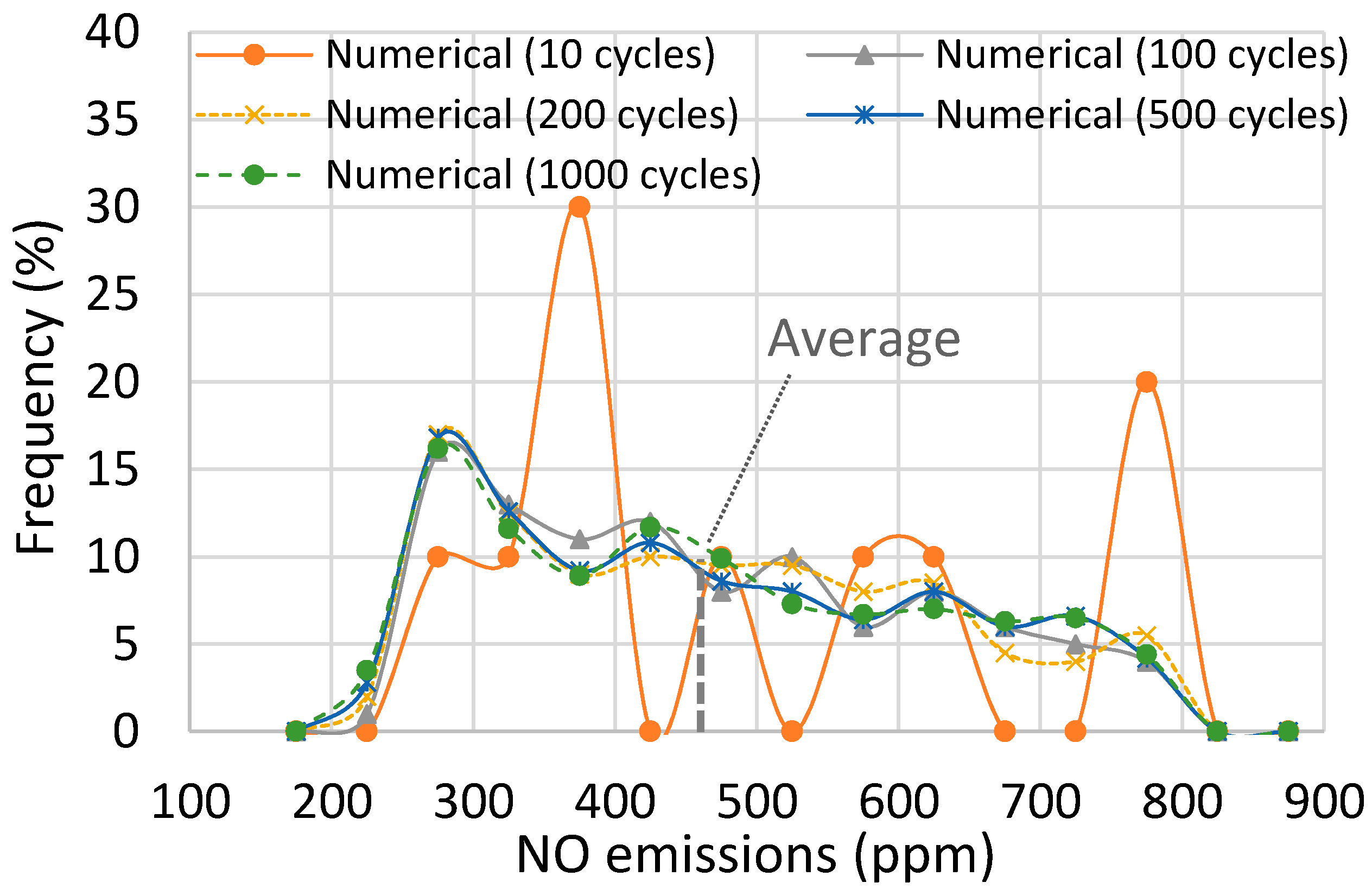


© 2019 by the authors. Licensee MDPI, Basel, Switzerland. This article is an open access article distributed under the terms and conditions of the Creative Commons Attribution (CC BY) license (http://creativecommons.org/licenses/by/4.0/).
Share and Cite
Kosmadakis, G.M.; Rakopoulos, C.D. A Fast CFD-Based Methodology for Determining the Cyclic Variability and Its Effects on Performance and Emissions of Spark-Ignition Engines. Energies 2019, 12, 4131. https://doi.org/10.3390/en12214131
Kosmadakis GM, Rakopoulos CD. A Fast CFD-Based Methodology for Determining the Cyclic Variability and Its Effects on Performance and Emissions of Spark-Ignition Engines. Energies. 2019; 12(21):4131. https://doi.org/10.3390/en12214131
Chicago/Turabian StyleKosmadakis, George M., and Constantine D. Rakopoulos. 2019. "A Fast CFD-Based Methodology for Determining the Cyclic Variability and Its Effects on Performance and Emissions of Spark-Ignition Engines" Energies 12, no. 21: 4131. https://doi.org/10.3390/en12214131
APA StyleKosmadakis, G. M., & Rakopoulos, C. D. (2019). A Fast CFD-Based Methodology for Determining the Cyclic Variability and Its Effects on Performance and Emissions of Spark-Ignition Engines. Energies, 12(21), 4131. https://doi.org/10.3390/en12214131





